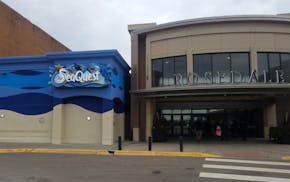The crocheting habit Anna Shewmaker has harbored since college isn't cheap, but the 28-year-old was more preoccupied with yarn color than cost when shopping at The Yarnery in St. Paul on Wednesday afternoon.
"I like seeing the joy on people's faces when I give them my creation," Shewmaker said, a bright blue swatch and a few skeins in her hands.
Minnesotans are still spending money — on groceries and gas, restaurants and clothes, and yes, yarn — but consumption is slowing as the economy levels out from the disruptions of the COVID-19 pandemic, according to federal data released Wednesday.
The U.S. Bureau of Economic Analysis (BEA) reported consumer spending in Minnesota rose 8.3%, or about $302 billion, in 2022, mirroring the national trend of back-to-back years of growth after a decline in 2020. But signs point to a slowdown: The spending increase last year was lower than in 2021, both in Minnesota and nationally. Meanwhile, consumption is shifting from goods to services, a sector of the economy that ground to a halt at the height of the pandemic.
Erick Garcia Luna, regional outreach director at the Minneapolis Fed, said the spending slowdown is a welcome development.
"This is all a big readjustment," he said.
After a nearly 13% increase between 2020 and 2021, Americans spent 9.2% more in 2022, according to the BEA, which cited housing and utilities, health care and food services and accommodations as the main drivers behind the $17.5 trillion bump. In Minnesota, where total per capita expenditures of about $53,000 fell within hundreds of dollars of the country as a whole, housing and utilities also led the increase.
Housing and health care reliably top the list of how people spend their money, said Steven Zemanek, an economist at the BEA.
"You can go and spend to your heart's content at a restaurant, and you're really going to have to go to a lot of expensive restaurants for it to equal the expenditures that you're paying for your rent," he said.
The spending trend has continued nationally, with an $83.6 billion bump in August. Personal income rose $87.6 billion the same month — including a $46.6 billion increase in disposable income — in part because of compensation increases.
At the same time, the prices of essential goods and services that led to the August spending uptick — categories like housing, utilities, gas and health care — continue to climb and contribute to rising poverty. The Consumer Price Index (CPI) for all urban consumers increased 0.6% in August, largely because of rising gas prices, according to the U.S. Bureau of Labor Statistics.
"There is a legitimate case that, on average, people are doing better," said Tyler Schipper, an associate professor of economics at the University of St. Thomas. But there are also a lot of people for whom that's not the case, he said, and high prices for essentials like food and gas remain economic touchpoints for consumers.
"Many people are not sitting down and trying to look at the big macroeconomic picture," Schipper said. "They are rightly concerned about their personal economies."
Declining pandemic savings, ongoing financial pressures and fears of a coming recession — whether warranted or not — are affecting how people spend and plan. A global Deloitte consumer survey, conducted monthly since April 2020, found 44% of U.S. respondents in August were delaying large purchases and less than half feel they can afford to spend money on things that bring them joy.
But Deloitte also found most consumers across ages, genders and income levels continue to make purchases to treat themselves, from food to electronics.
The Yarnery co-owner Scott Rohr said the shop has made an effort to stock yarn at a variety of price points, from around $4 a skein to $30. Most customers shop across that range, he said, maybe opting for less-expensive yarn if they're knitting a machine-washable item for a child and splurging on hand-dyed fibers if they're planning something special for themselves.
"Yarn is, of course, a discretionary expense, but I think that for a lot of people during the pandemic especially, it fulfilled this need for calm and comfort," Rohr said. "What people spend on this craft, people think of that as a self-care kind of thing. It doesn't feel like frivolous spending to people."
The half-century-old yarn shop made it through the pandemic with online sales and deliveries, Rohr said, and hasn't seen much customer belt-tightening since.
"We all keep waiting for the recession that may or may not come," he said. "We're just doing the best we can, and so far, so good."

Family of paralyzed teen sues Mayo Clinic over back surgery

Troubled chain of SeaQuest aquariums wants bankruptcy judge to approve $80,000 sale

Ramstad: Walz tries to slow runaway spending, moving to political middle

